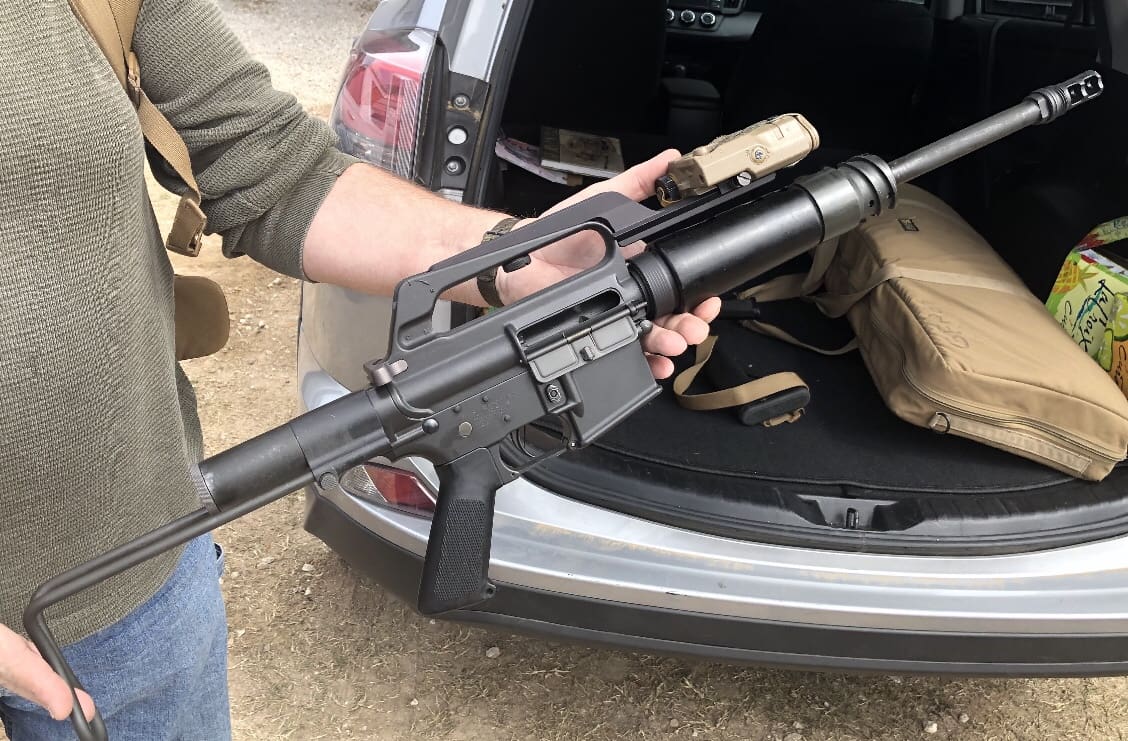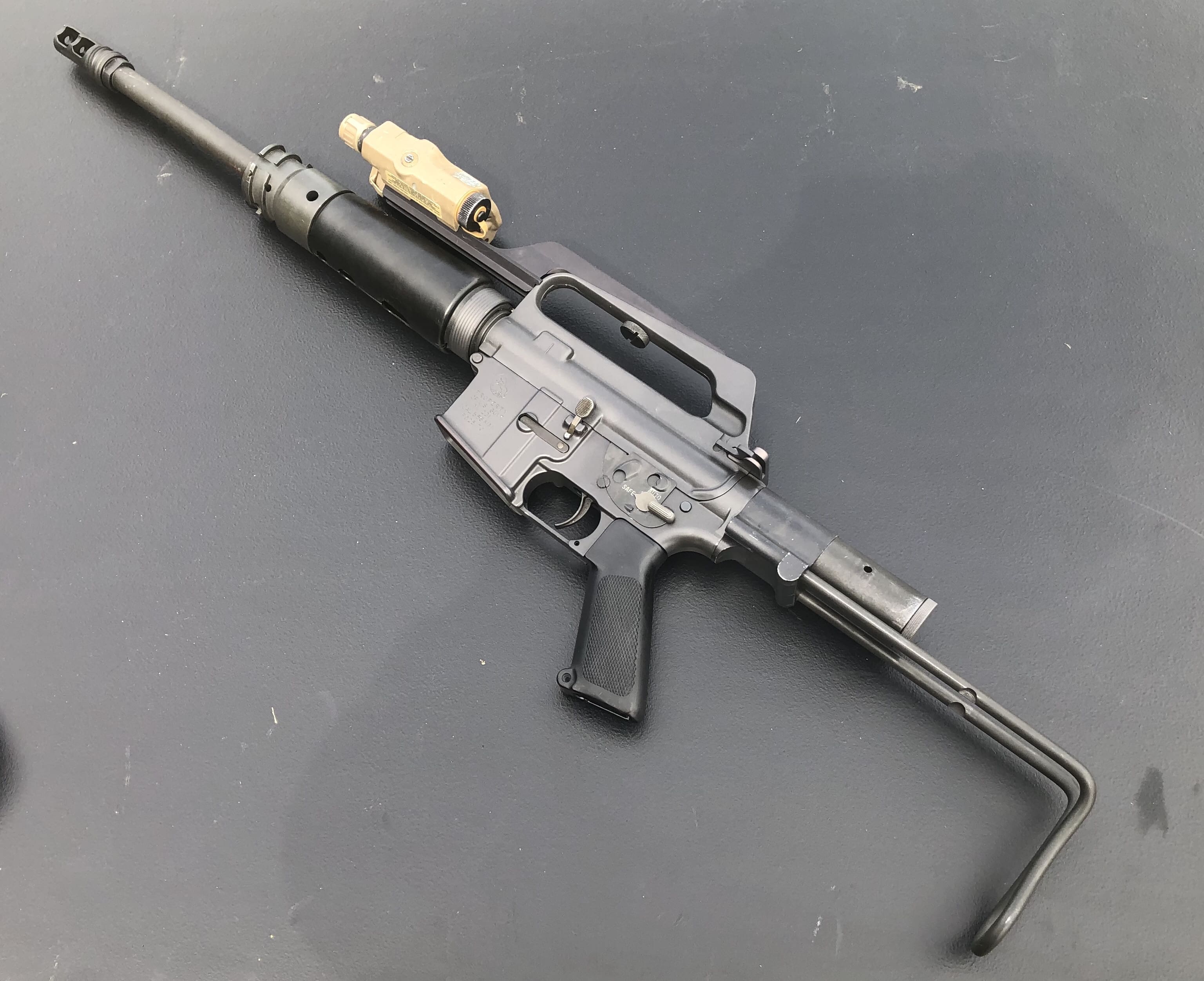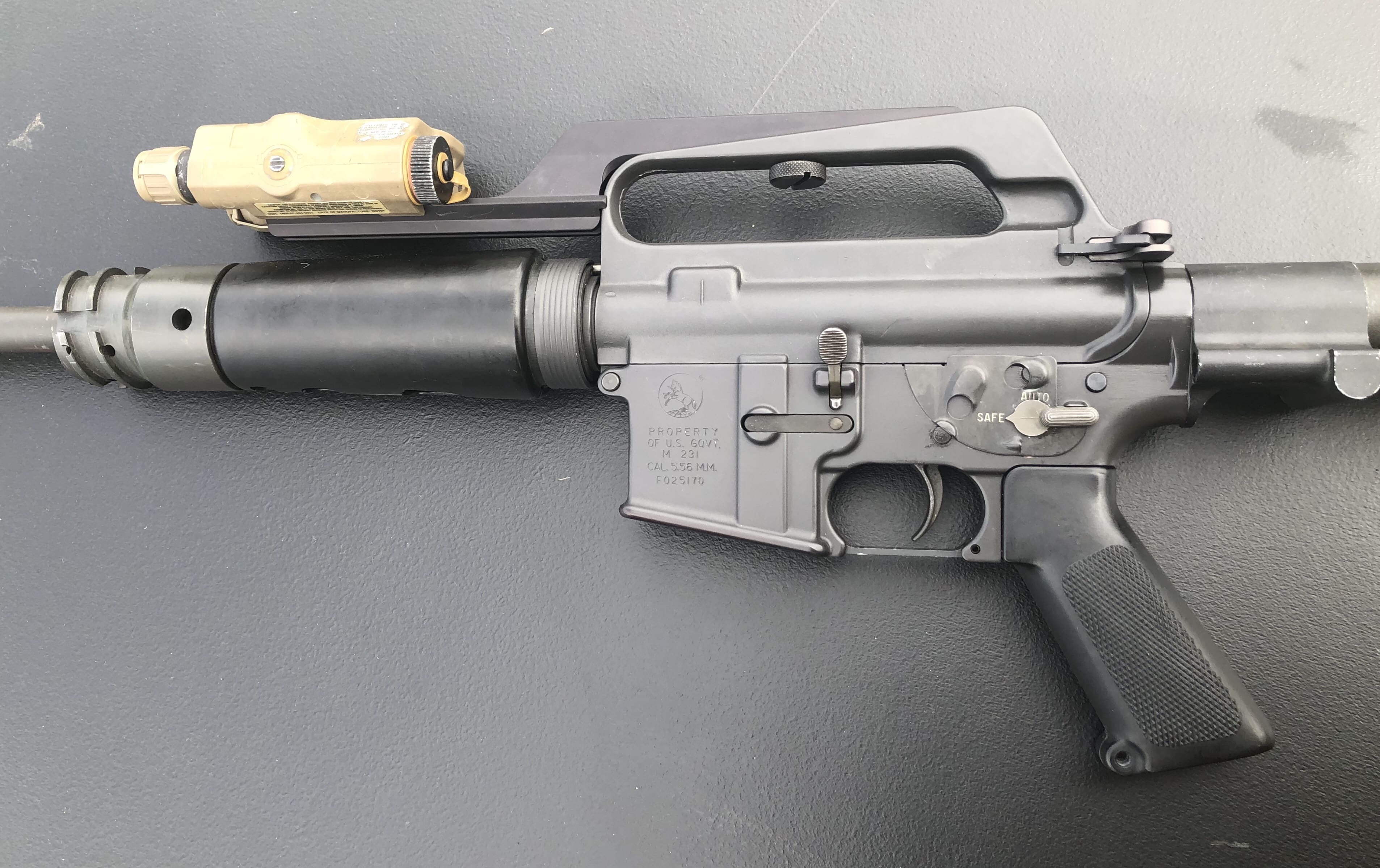The M231 Firing Port Weapon is a rather obscure footnote in US Small Arms history. Thanks to Marty Bordson, owner of Badger Ordnance, I recently got the chance to fire one.

Designed to be shot from the firing ports of the M2 Bradley Fighting Vehicle (the M2 was the Infantry variant), the M231 was based on the M16A1. As you can see, it featured a short, threaded handguard which was screwed into place in the firing port. Initially, the M231 featured a wire stock, reminiscent of the M3 “Grease Gun” but it was later removed as it was prone to rattle off and become a nuisance in the vehicle. Although, the real reason was probably to dissuade the rifle’s use in place of the standard M16 by dismounted Infantry.

Below, you can see the modified selector lever, peculiar to the M231. It is either SAFE or AUTO and the SOP was to fire Tracer ammo, aimed through a vision block. The M231 was meant to deal with enemy dismounts who might try to engage from the sides and rear of the Bradley.

Marty made a couple of mods to the rifle in order to use it while hunting hogs. He changed out the flash hider so it would accept a Mack Brothers suppressor and fitted a mount and PEQ-15 to the carrying handle. Obviously, that didn’t do me any good during the day. I sighted over the top of the receiver and aimed at the berm.

Perhaps the most interesting feature of the M231 is that it fires from the open bolt to help keep it cool. With a cyclic rate of around 1200 rpm, the added suppressor just sped it up, and also exacerbated the gas issues. I also had access to a Magpul D60 PMAG, while those using the M231 in its heyday would have only had USGI 30 rd magazines. My firing hand was covered in carbon when the magazine was finished and I had to stop halfway through, due to the back gas. The video below shows me firing the second half of the magazine. I can only imagine what it was like in the vehicle when there were six firing at once. For a period, there was supposed to be a vent hose for the gas, but the few accounts I’ve heard of these actually being fired from within the vehicle, it didn’t work.
Eventually, the M2 Bradley was upgraded with slab sides designed to accept reactive armor panels which eliminated the side firing ports. However, the M231 is said to soldier on, at least in arms rooms, as the M2 has retained the two firing ports on the rear hatch. As late as the invasion of Iraq, armored troops were spotted using the M231.


I’d love to see the inside of that lower group, curious of how it is firing from an Open Bolt. Thanks SSD!
Forgotten Weapons has a video on this gun.
There are photographs of the internals disassembled in the Vickers Guide as well, and some photographs online of full disassembly if you search.
Saw a national guard guy carrying this and his buddy an m60 in Iraq 2006
That is a pretty cool bit of history there. without his mods, it had no sights? I don’t see a front post..
It does not need one for its intended purpose. A front post would make it difficult to get the weapon into and out of the ports, if not impossible depending on where it was placed.
No sights–the weapon is intended to be threaded gas block fits into the Bradley firing port, and the weapon is aimed through a periscope using tracers.
Most issued weapons did not have the wire stock installed either, to discourage their use dismounted… not that that ever stopped anyone.
Oh man, my buddy was telling me about these. He was a mechanized infantry kid in 3/3ID 2002-2005, spending all his time in Bradleys (including a particularly memorable invasion). He said firing these things was hilarious; you couldn’t aim them, they expended all of their rounds in about half a second, and they sounded like zippers when doing so. He only fired them at range SPENDEXes, but be loved doing it.
I saw these with Bradley crews in Ramadi in 2004-05. Pretty cool piece of history.
Correct me if I’m wrong, but these weren’t even rifled originally, were they? Given the cyclic rate, I read at some point the barrels were just smooth bore.
The prototype had a front sight, but that was deleted, makes sense for the role but illustrates it wasn’t meant for dismount, ever.
I saw some at Ft Hood while doing Small Arms Repair in 2009, which was super neat since I first saw it in “Small Arms of the World” in 1988.
Seemed to the kid that I was that it was a successor to the XM177, which was the kid-size M16 (also Sarge in “Tour of Duty” was awesome).
Now I understand that it was a vehicle accessory that could be detached for PMCS and mostly collects dust until the next Arms Room inventory.
Everyone already had an A1/A2/M4, and firing the M231 on the move sounds cool but isn’t.
The sightless trough could haven been modified with a improvised rear ghost ring and a screw drilled into the front of the trough to make it usable outside the vehicle, even if only at 25 meters.
There are any number of admittedly current PDW stocks that would fit inside the footprint of the receiver extension.
My pick would be a chopped 1st gen M4 stock w/ corresponding tube.
If it had the ability to swap to closed bolt/semi-auto or at least select a reduced cyclic rate, it could have replaced the Grease Gun before the M4 hit the scene and eventually replaced everything.
Someone go poke Brownells and get me an upper, I’ll figure out the sights and lower myself.
Also, DOE 9mm… can someone build an integral suppressor under/into/or as a replacement for the hand guard?
Brownell’s need to make a Retro model of this and the 608 for consumers who enjoy Hobbesian Life weapons: Nasty, Brutish and Short.
Haven’t seen one of those since Desert Storm. Almost forgot about that thing.
My national guard unit still has 12 of these things. We never use them but they are in the vault.
Even after the M2A2 (slab sides) came out units retained these. The ramp had two gun ports.
Little mentioned problem with these was driving in the woods. Trees had a tendency to bend the barrels (and strip rucksacks off the sides). Same thing happened if you left the gun in when the ramp was dropped.
During Desert Storm several Bradley commanders had one of these bungee/550 corded on top of the turret to dissuade any Iraqis from trying to get too close when we drove over their positions.